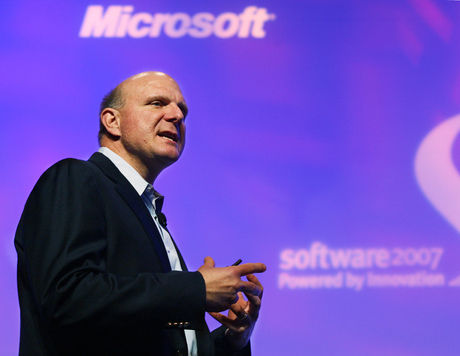Ballmer bails from Microsoft board

Former Microsoft CEO Steve Ballmer has stepped down from the company’s board of directors in order to focus on teaching and his recent acquisition, the Los Angeles Clippers. But as one of Microsoft’s largest shareholders, Ballmer may still hold significant power at the company.
Microsoft revealed Ballmer’s decision last week by publishing a letter from Ballmer to the company’s new CEO, Satya Nadella.
Ballmer wrote in the letter that in the six months since leaving the position of CEO, he has “become very busy”.
“I see a combination of the [Los Angeles] Clippers, civic contribution, teaching and study taking a lot of time,” he wrote.
Ballmer bought the Clippers basketball team for US$2 billion in early August.
“I think it would be impractical for me to continue to serve on the board, and it is best for me to move off. The [next few months] will be hectic between teaching a new class and the start of the NBA season so my departure from the board is effective immediately,” he wrote.
According to Business Insider, Ballmer will teach a Masters of Business Administration at Stanford’s Graduate School of Business in the next few months and will next year teach a course at University of Southern California’s Marshall School of Business.
Ballmer joined Microsoft in 1980, becoming the company’s CEO in 2000. He retired as CEO in February 2014.
The Wall Street Journal cited an anonymous source as saying that Ballmer’s term on the board was slated to expire towards the end of the year, and Ballmer volunteered this month to leave early.
The source also said it was “reasonable to speculate” that the company’s directors wouldn’t have nominated Ballmer for another year on the board once his time was up.
Nomura Securities analyst Rick Sherlund forecast that the dynamics of the Microsoft board may change in the future, according to The New York Times.
“This was a board that took a lot of direction from Steve Ballmer for quite a few years,” Sherlund is quoted as saying.
Bloomberg had analyst Brendan Barnicle saying that Ballmer’s departure from the board means that Nadella will have room to put more of his stamp on the company.
Continued influence
But while Ballmer may have left the board of directors, his presence as a shareholder will likely still be felt.
“I hold more Microsoft shares than anyone other than index funds,” he wrote in the letter to Nadella. “I expect to continue holding that position for the foreseeable future.”
According to Forbes, Ballmer owns more than 333 million shares of Microsoft, worth more than US$15 billion.
According to some commentators, Ballmer holding on to his shares will mean he may exert influence on the company’s direction in the future.
In a blog entry at redmondmag.com titled ‘Ballmer’s Departure: A Win for Microsoft and Clippers’, one author wrote: “Even though Ballmer is no longer on the board with voting rights, he’s still the company’s largest shareholder and if he was to align himself with activist investors, he could make his already audible voice heard. As such it would be foolish to write him off.”
In his letter to Nadella, Ballmer signalled his intention to provide input. “Count on me to keep ideas and inputs flowing. I promise to support and encourage boldness by management in my role as a shareholder in any way I can.”
Nadella’s response
Microsoft also published Nadella’s response to Ballmer’s letter. The current CEO spoke glowingly of the departing director.
“Thank you for all of your support during my transition this year and for the past 34 years. It’s been a great privilege to have worked with you and learned from you. Under your leadership, we created an incredible foundation that we continue to build on,” Nadella wrote.
“While your insights and leadership will be greatly missed as part of the board, I understand and support your decision,” he wrote. “I also look forward to partnering with you as a shareholder.”
Four ways AI can finally make threat intelligence useful and not just noisy
Done poorly, threat intelligence is noise. But done well, it becomes one of the most powerful...
Australia’s top tech priorities for 2026
It is anticipated that AI will evolve from a pilot project to a productive standard, underpinned...
Why AI's longevity lies in utility, not novelty
The real potential of AI is in underpinning the invisible systems powering everyday business.



